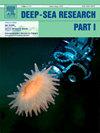西太平洋冬季不同类型漩涡中浮游植物群落的光生理状况
IF 2.1
3区 地球科学
Q2 OCEANOGRAPHY
Deep-Sea Research Part I-Oceanographic Research Papers
Pub Date : 2024-09-24
DOI:10.1016/j.dsr.2024.104402
引用次数: 0
摘要
西太平洋(WPO)是世界上最活跃的漩涡区之一,经常观测到各种海洋过程,但对该区域漩涡内浮游植物群落及其光合生理状态的研究却很少。本文基于快速重复速率荧光测定法(FRRF),研究了 2021 年冬季 WPO 暖核心漩涡和冷核心漩涡内浮游植物群落的生物光学参数及其生理状态。本文研究了西太平洋海域两种相反类型漩涡的环境因子、浮游植物群落参数、叶绿素 a(Chl a)以及各种生物光学参数。结果表明,暖涡和冷涡中 DCM 的最大值[Fv/Fm,0.18-0.26(暖涡),0.14-0.28(冷涡)]和有效光合效率[Fq'/Fm',0.11-0.23(暖涡),0.10-0.27(冷涡)]、电子传输速率 ETRRCII [0.002-6.18 mol e- mol RCII-1 s-1 (暖涡), 0.002-4.94 mol e- mol RCII-1 s-1 (冷涡)]和初级生产潜力 PPmax [0.68-118.19 mg C (mg Chl a)-1 day-1 (暖涡), 2.47-243.49 mg C (mg Chl a)-1 day-1 (冷涡)]。在暖涡中,温度和 Chl a 浓度对 Fv/Fm 和 Fq'/Fm' 有显著影响,而在冷涡中,Fv/Fm 和 Fq'/Fm' 与温度的相关性不显著,Fv/Fm 仅与 DIP 显著负相关。光照是影响漩涡中浮游植物群落电子传递能力和初级生产潜力的主要变量,而大型蓝藻和甲藻则对冷漩涡的初级生产潜力有重要贡献。此外,两个漩涡中心都具有较高的初级生产潜力,冷漩涡的初级生产潜力高于暖漩涡,根据微观分析,这一现象可能是由于浮游植物群落间电子传递速率的差异造成的。本文章由计算机程序翻译,如有差异,请以英文原文为准。
Photophysiological status of phytoplankton communities in different types of eddies during winter in the western Pacific Ocean
The Western Pacific Ocean (WPO) is one of the most active eddy regions in the world, where a variety of ocean processes are frequently observed, but little research has been conducted on the phytoplankton communities and their photosynthetic physiological status within the eddies in this region. The bio-optical parameters of phytoplankton communities and their physiological status within the warm core and cold core eddies of the WPO during the winter of 2021 were investigated based on fast repetition rate fluorometry (FRRF). In this paper, environmental factors, phytoplankton community parameters, chlorophyll a (Chl a), and various bio-optical parameters were investigated for two opposite types of eddies at the WPO. The results show the maximum [Fv/Fm, 0.18 to 0.26 (warm eddy), 0.14 to 0.28 (cold eddy)] and effective photosynthetic efficiency [Fq'/Fm', 0.11 to 0.23 (warm eddy), 0.10 to 0.27 (cold eddy)] of the DCM for both warm and cold eddies, the electron transport rates ETRRCII [0.002–6.18 mol e− mol RCII−1 s−1 (warm eddy), 0.002–4.94 mol e− mol RCII−1 s−1 (cold eddy)] and the primary production potential PPmax [0.68–118.19 mg C (mg Chl a)−1 day−1 (warm eddy), 2.47–243.49 mg C (mg Chl a)−1 day−1 (cold eddy)] for different types eddies. In warm eddy, temperature and Chl a concentrations had significant effects on Fv/Fm and Fq'/Fm', while in cold eddy the correlation of Fv/Fm and Fq'/Fm' with temperature was not significant, and Fv/Fm was significantly negatively correlated with DIP only. Light was the main variable affecting the electron transport capacity and primary production potential of the phytoplankton community in the eddies, while larger cyanobacteria and dinoflagellates contributed significantly to the primary production potential of the cold eddy. In addition, both eddies centers had higher primary production potentials, with the cold eddy had a higher primary production potential than the warm eddy, based on microscopic analysis this phenomenon may be due to differences in electron transfer rates between phytoplankton communities.
求助全文
通过发布文献求助,成功后即可免费获取论文全文。
去求助
来源期刊
CiteScore
4.60
自引率
4.20%
发文量
144
审稿时长
18.3 weeks
期刊介绍:
Deep-Sea Research Part I: Oceanographic Research Papers is devoted to the publication of the results of original scientific research, including theoretical work of evident oceanographic applicability; and the solution of instrumental or methodological problems with evidence of successful use. The journal is distinguished by its interdisciplinary nature and its breadth, covering the geological, physical, chemical and biological aspects of the ocean and its boundaries with the sea floor and the atmosphere. In addition to regular "Research Papers" and "Instruments and Methods" papers, briefer communications may be published as "Notes". Supplemental matter, such as extensive data tables or graphs and multimedia content, may be published as electronic appendices.

 求助内容:
求助内容: 应助结果提醒方式:
应助结果提醒方式:


